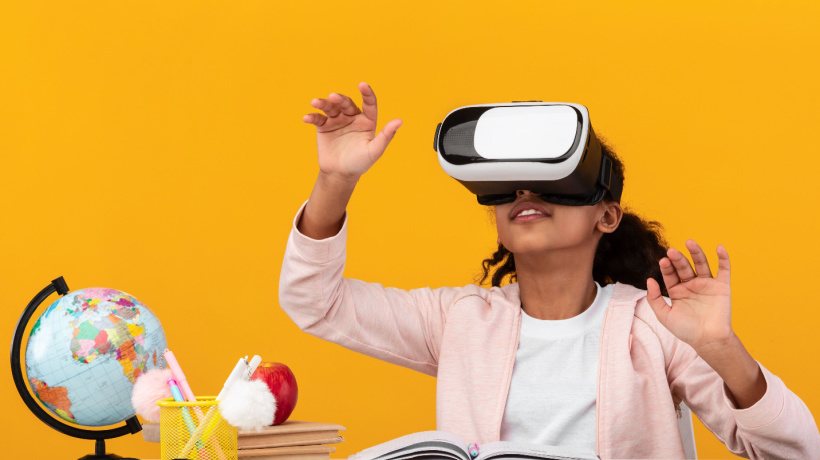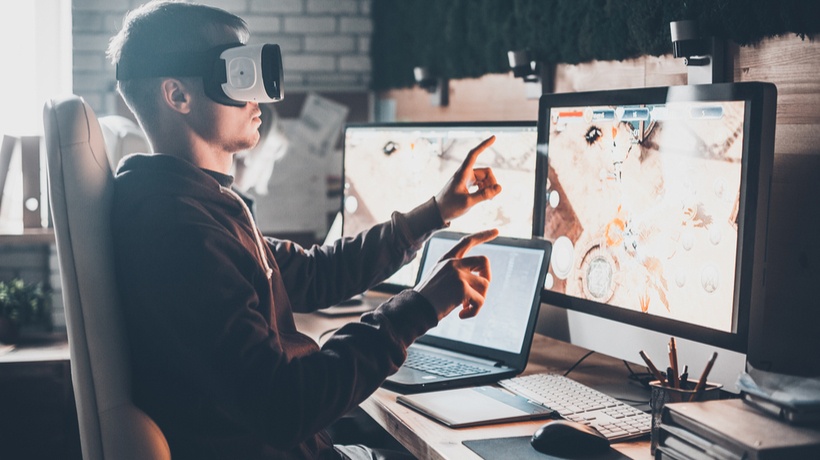How Will VR Affect eLearning In The Future?
In a world of rapidly evolving technology, eLearning is at the forefront of digital transformation and innovation. One latest technology that is no longer just a concept on paper and is transforming the education industry is Virtual Reality (VR).
Thanks to smart devices, VR has become a norm in our households and various industries, including education. We can now confidently say, "The future is today!" eLearning is an industry that has seen rapid growth and improvements in the past decade, even before the COVID-19 pandemic.
However, the year 2020 changed everything, and eLearning is no exception. According to a report by Global Marketing Insights, eLearning is expected to be worth $375 billion by 2026. The long-term impacts of the coronavirus pandemic have created a need for better and more immersive eLearning platforms—and what better way to achieve that than with VR.
What Is VR?
VR or Virtual Reality is the use of computer technology to recreate a 3D interactive environment that users can interact with. These simulated environments are different from the real world but are highly immersive. In VR, the user feels like a part of the 3D virtual world.
To experience the VR content, users need to have a VR headset. There are multiple options available in the market, like Oculus Quest, Sony, HTC, etc. With VR, instead of watching content on the screen, users can immerse themselves in the 3D environment and also interact with it. This experience is both visual and auditory, which makes it best for eLearning.
VR In eLearning
Virtual Reality has a lot of potential to boost eLearning and create interactive learning modules by incorporating 3D graphics with real-world experiences. With a surge in smart devices and VR compatible software, this immersive technology is growing in popularity.
VR driven learning experiences are all accumulative. As opposed to traditional eLearning, it offers students an opportunity to interact with the reading specimen using all the five senses. For example, as assimilative as dissecting a cadaver to learn the human anatomy in a medical school is, it is a one-time experience.
Now, imagine being able to dissect a cadaver and then have it rebuilt so you could refine your skills and get the most out of one human assembly. That can only currently be achieved through VR technology. Similarly, VR technology has also revolutionized the engineering and aviation industry by offering hands-on experience and learning through immersive simulation.
3 Practical Ways Of Using VR Technology In eLearning
Here are 3 practical ways that VR technology is changing eLearning across various platforms all over the world.
1. Training Simulations
Through VR technology, companies can provide their students and trainees with online training simulations by completely immersing them in a virtual environment. This technology is being widely used by training institutes all over the world, especially in the fields of aviation, electronics, medical, etc.
The major idea behind this VR integration is that it is less distracting as compared to other technologies like mobile phones, laptops, computers, etc. For example, with immersive technologies like VR and AR (Augmented Reality), training simulations allow students to step into the virtual 3D set up like the real world.
The simulation is not entirely visual and auditory as users can interact with the virtual elements, which offers great learning opportunities and real-life experiences.
2. Gamification
Gamification is an exciting trend in the digital world and has been taken up by almost every industry, including marketing, IT, businesses, and also eLearning. Through VR, game elements can be seamlessly integrated into eLearning and make learning more interactive and fun.
With immersive gamification through VR, you can provide better learning and highly immersive real-world experiences to students. Industries using architecture, interior design, civil engineering, etc., can incorporate AR and VR technology game features to improve learning.
It will provide students with a platform where they can interact with various virtual elements. Gamification will make eLearning more fun and also help increase retention rates.
3. Customized Online Courses
VR and smart devices also allow eLearning platforms to customize online courses for students. It has also enabled institutes to move away from the traditional teaching methods and online courses to more advanced courses, more like a video game where students are placed in a virtual world and go through real-life experiences to test their decision-making abilities. Our traditional eLearning platforms are quite restricted, as they mostly offer theoretical knowledge, instead of practical, hands-on experiences.
Limitations
VR is no doubt an excellent immersive technology that is revolutionizing eLearning and bringing more learning opportunities for students. In terms of eLearning platforms, VR has some limitations, including high costs, mobility constraints, the need for a dedicated learning space, and online privacy issues.
However, with rapid advancement in technology and changing times, these limitations don’t prove to be a hindrance. The very factors that limited the mass utilization of VR tech have become a key asset to continuing education during the current coronavirus pandemic.
Therefore, we no longer look at VR technology as something that is not practical or accessible. It is the future of eLearning. VR is providing companies with a smart platform for creating a new environment for employee training and online courses.
Immersive Technology In eLearning Bringing Us Closer To Reality
The 2020 coronavirus pandemic has made millions of people swap their classrooms with kitchen tables and sofas. It is time the education industry moved away from traditional learning by integrating VR and other smart technologies.
VR is a revolutionary technology that has already brought about exciting changes in the eLearning sector, and various companies have already embraced this exciting tool as part of their futuristic approach.
Most popular digital marketing service providers are also starting to integrate VR into their marketing strategies, as it is the next big thing in the digital world. Now, more than ever, rather than being a fancy technology for gamers and entertainment lovers, VR will continue to evolve in the eLearning sector.








